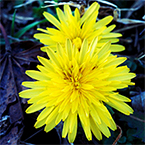Dandelion

On this page:
Introduction
This fact sheet provides basic information about dandelion—common names, what the science says, potential side effects and cautions, and resources for more information.
Dandelion greens are edible and are a rich source of vitamin A. Dandelion has been used in many traditional medical systems, including Native American and traditional Arabic medicine. Historically, dandelion was most commonly used to treat liver diseases, kidney diseases, and spleen problems. Less commonly, dandelion was used to treat digestive problems and skin conditions. Today, traditional or folk uses of dandelion include use as a liver or kidney “tonic,” as a diuretic, and for minor digestive problems.
The leaves and roots of the dandelion, or the whole plant, are used fresh or dried in teas, capsules, or extracts. Dandelion leaves are used in salads or as a cooked green, and the flowers are used to make wine.
What the Science Says
There is no compelling scientific evidence for using dandelion as a treatment for any medical condition.
Side Effects and Cautions
- Dandelion use is generally considered safe. However, there have been rare reports of upset stomach and diarrhea, and some people are allergic to the plant.
- People with an inflamed or infected gallbladder, or blocked bile ducts, should avoid using dandelion.
- Tell all your health care providers about any complementary health practices you use. Give them a full picture of what you do to manage your health. This will help ensure coordinated and safe care. For tips about talking with your health care providers about complementary and alternative medicine, see NCCAM's Time to Talk campaign.
Sources
- Dandelion. Natural Medicines Comprehensive Database Web site. Accessed at www.naturaldatabase.com on June 9, 2009.
- Dandelion (Taraxacum officinale). Natural Standard Database Web site. Accessed at www.naturalstandard.com on June 9, 2009.
- Dandelion root with herb. In: Blumenthal M, Goldberg A, Brinckman J, eds. Herbal Medicine: Expanded Commission E Monographs. Newton, MA: Lippincott Williams & Wilkins; 2000:81–83.
For More Information
NCCAM Clearinghouse
The NCCAM Clearinghouse provides information on NCCAM and complementary health approaches, including publications and searches of Federal databases of scientific and medical literature. The Clearinghouse does not provide medical advice, treatment recommendations, or referrals to practitioners.
PubMed®
A service of the National Library of Medicine (NLM), PubMed® contains publication information and (in most cases) brief summaries of articles from scientific and medical journals.
Office of Dietary Supplements (ODS), National Institutes of Health (NIH)
ODS seeks to strengthen knowledge and understanding of dietary supplements by evaluating scientific information, supporting research, sharing research results, and educating the public. Its resources include publications (such as Dietary Supplements: What You Need to Know), fact sheets on a variety of specific supplement ingredients and products (such as vitamin D and multivitamin/mineral supplements), and the PubMed® Dietary Supplement Subset.
NIH National Library of Medicine's MedlinePlus
This publication is not copyrighted and is in the public domain. Duplication is encouraged.
* Note: PDF files require a viewer such as the free Adobe Reader.
